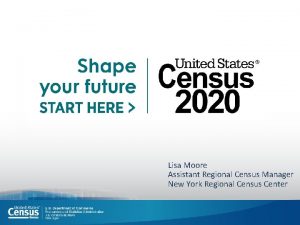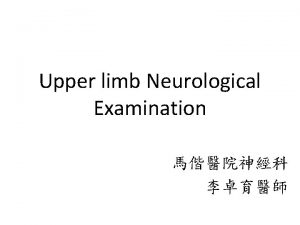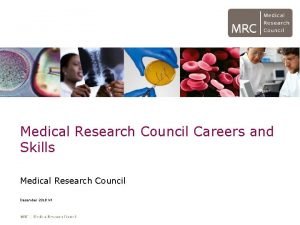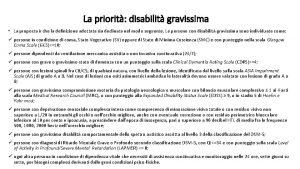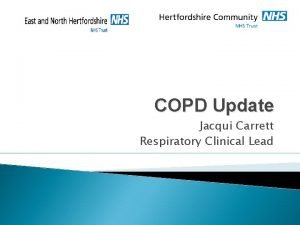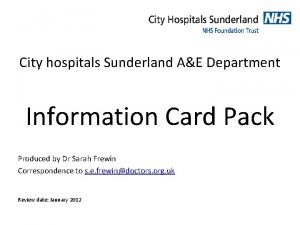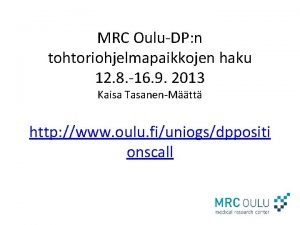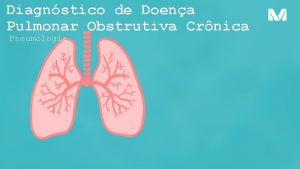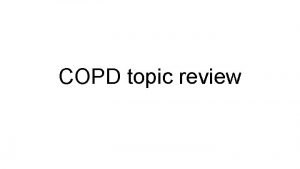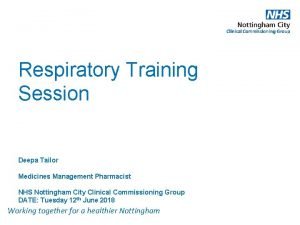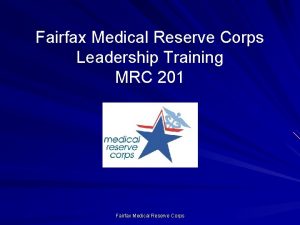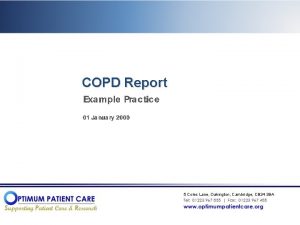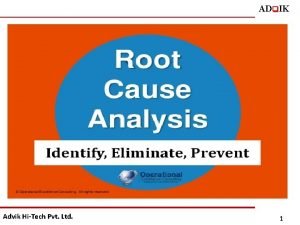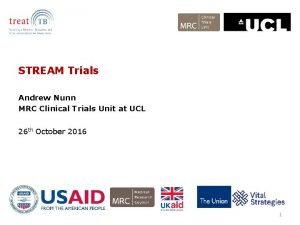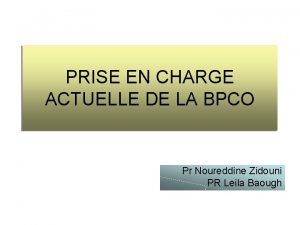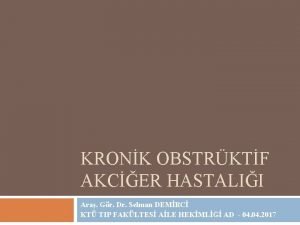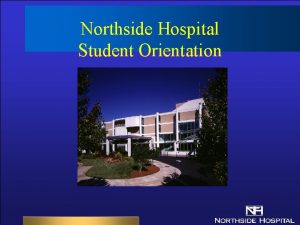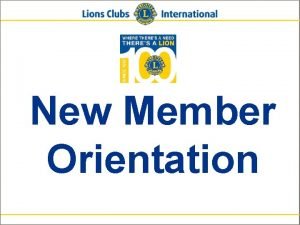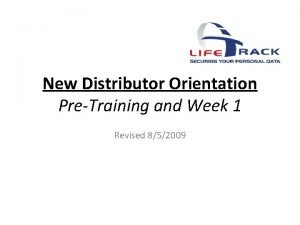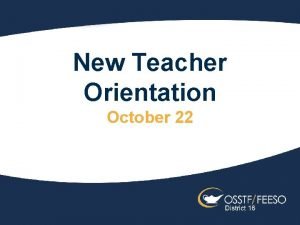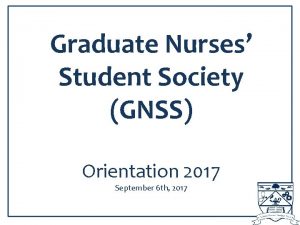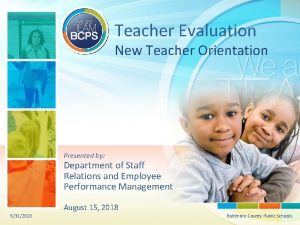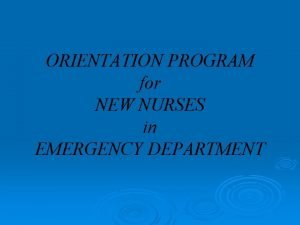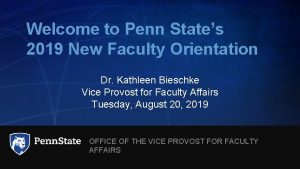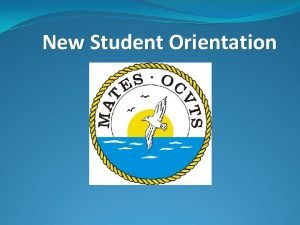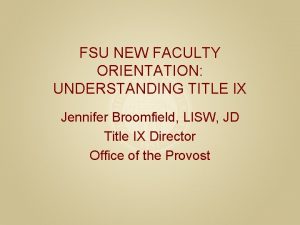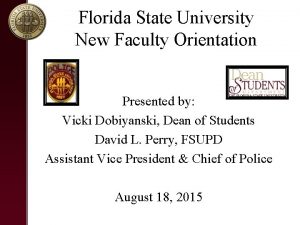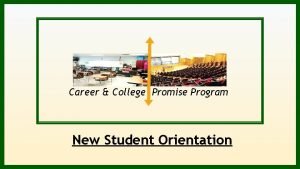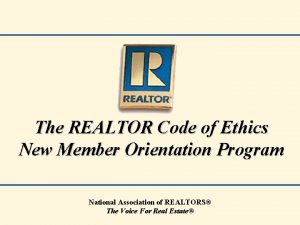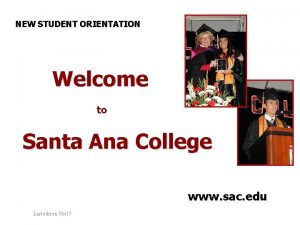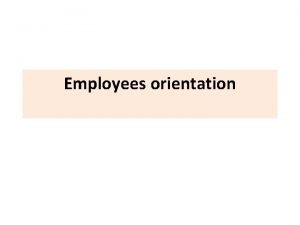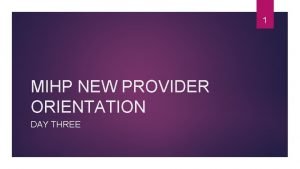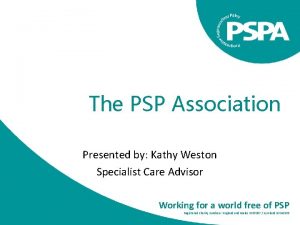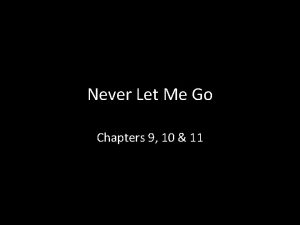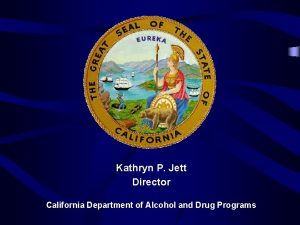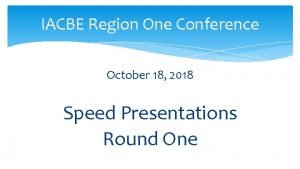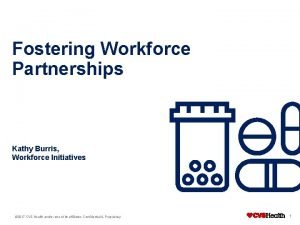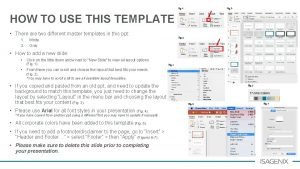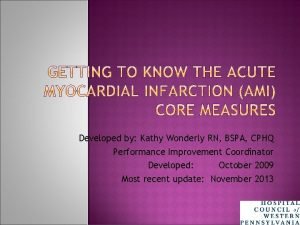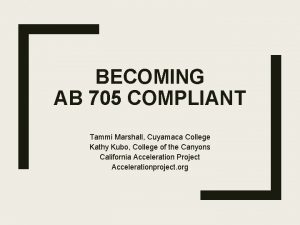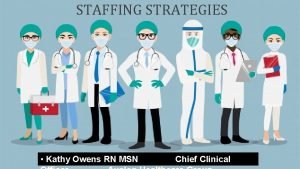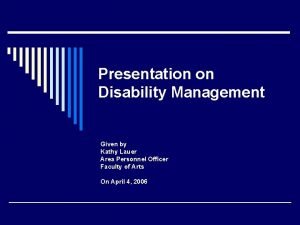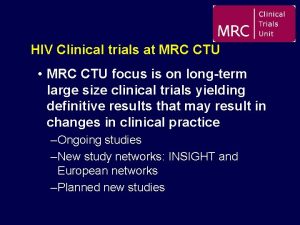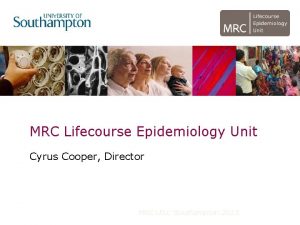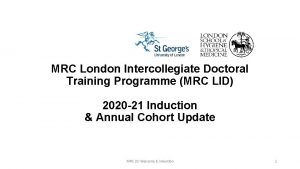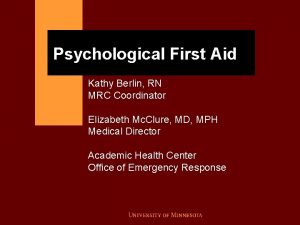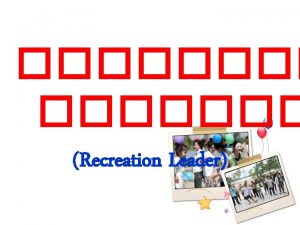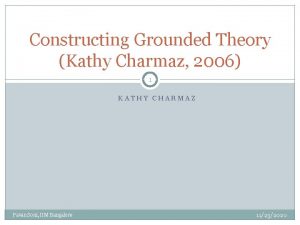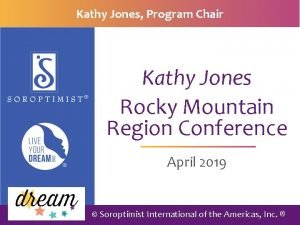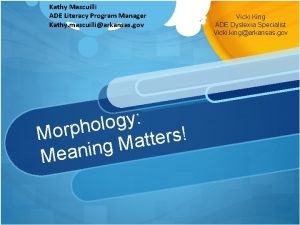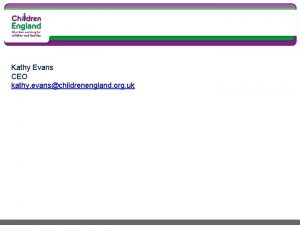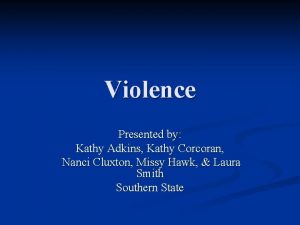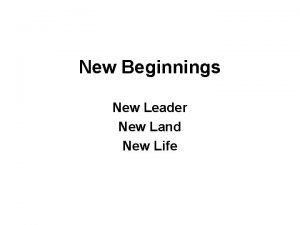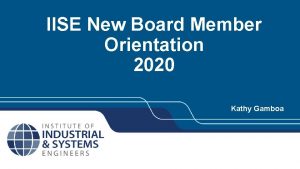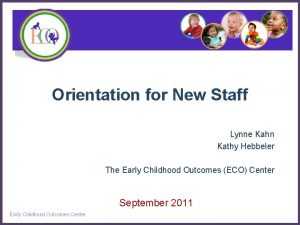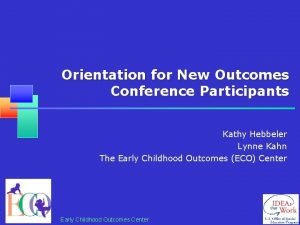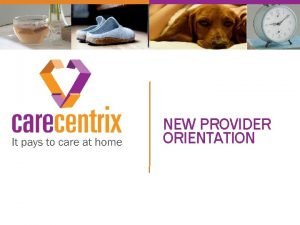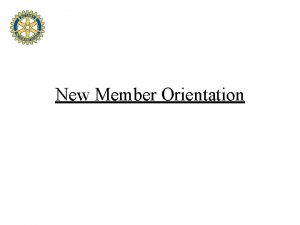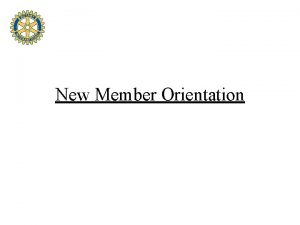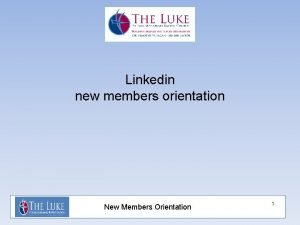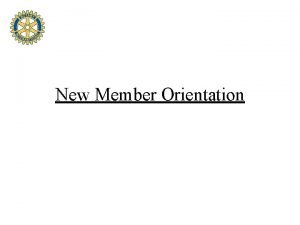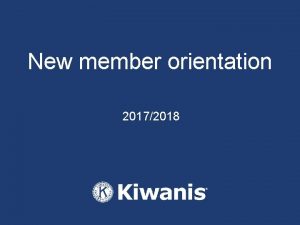MRC New Leader Orientation Kathy Handra Regional MRC































































- Slides: 63

MRC New Leader Orientation Kathy Handra Regional MRC Coordinator - Region IV United States Dept. of Health and Human Services Atlanta, Georgia

2012 Seasonal Leadership and Training Summit December 5 -7, 2012 The content of this presentation/document does not represent the official views or policies of the Division of the Civilian Volunteer Medical Reserve Corps/Office of the Surgeon General nor of the Department of Health and Human Services. Unless otherwise noted, the content represents solely the advice, views, and opinions of the speaker as presented at the 2012/2013 MRC Seasonal Training and Leadership Summits for the consideration of the participants.

Objectives 1. Participants will be able to describe the MRC Vision, Mission and Goals. 2. Participants will be able to demonstrate leadership principles necessary to obtain community buy-in. 3. Participants will be able to identify education, training and network resources for unit development. 3

Activity 10 minutes Please introduce yourself to the group and tell us one thing you would like to take away from this session.

Break 10 minutes

MRC Mission/Vision/Goals MRC Mission: Engaging volunteers to strengthen public health, emergency response and community resiliency. DCVMRC Mission: Support local efforts to establish, implement, and sustain MRC units nationwide. DCVMRC/MRC Vision: Dedicated Volunteers & Strong, Active Units. . . Building Resiliency and Reducing Vulnerability. 6

MRC Mission/Vision/Goals Cont’d DCVMRC Goals Serve as the national voice of the MRC network Promote MRC participation in public health and response efforts at all levels Support the growth and sustainability of the nationwide network of MRC units Strengthen our internal capacity to support MRC units DCVMRC Strategic Plan

MRC History in Brief § September 11, 2001 - World Trade Center Disaster § October – November 2001 - Anthrax Events § January 2002 - USA Freedom Corps and Citizen Corps (national network of volunteers) established § July 2002 - Medical Reserve Corps (MRC) launched § February 2003 - Re-emergence of H 5 N 1 in isolated cases of human deaths § March 2003 - The SNS Program was returned to HHS for oversight & guidance

DCVMRC Federal Structure HHS Secretary Assistant Secretary for Health Assistant Secretary for Preparedness and Response Surgeon General Chief of Staff Medical Reserve Corps



What is the MRC About? It’s about local healthcare and non -healthcare volunteers working to strengthen the health and safety of the community. It’s about volunteers who support, assist and supplement the resources of the existing public health, medical and emergency response systems.

What is the MRC About? It’s about during emergencies, MRC volunteers may provide an important “surge” capability to area hospitals and LHD. It’s about building community resilience.

MRC Volunteers § The MRC is a national network of local groups of volunteers that include medical, non-medical and public health professionals interested in improving the health and safety of their local jurisdictions. § MRC units identify, screen, train and organize volunteers, and utilize them to support routine public health activities and augment preparedness and response efforts. § We encourage MRC unit leaders and members to serve as “Ambassadors” of the U. S. Surgeon General

No One is “Normal” Community-based: No two communities are the same All MRC Units • Provide an organizational structure for utilizing members • Pre-identify members • Verify professional licensure/certification • Train/prepare Units Vary By • Housing organizations • Partner organizations • Types/number of volunteers • Local mission/activities

Types of Volunteers

Numbers of Volunteers In Each Region

MRC Activities • Health screenings – Diabetes – Blood pressure – BMI, etc. • Health education & outreach activities – Health fairs – Child Safety Seat Check Ups – Safe Kids, etc. • Vaccination Clinic Operations • Augment health care providers or health care support staff • Shelter Operations – American Red Cross partnerships – Emergency Management

Activity Focus Areas § Administration § Community Preparedness § Emergency Response § Public Health § Training

Self Assessment Where Are We? Where Are We Going? How Are We Going To Get There?

Activity 20 minutes What are some activities you unit would like to do or has done? Please share with the group.

Factors For Success § Determine purpose and scope of unit § Establish common partnerships § Determine financial needs and funding sources § Determine organization structure and unit composition § Determine procedures for volunteer recruitment § Develop and implement procedures for volunteer screening § Develop a volunteer training program

Factors For Success Cont’d § Develop policy and procedures for volunteer utilization § Develop policies and procedures manual § Develop volunteer retention and recognition program § Develop and implement strategies for risk management § MRC unit participates in activities that fulfill its mission

Determine Purpose and Scope of MRC § Determine Jurisdiction Served § Conduct Community Needs Assessment § Develop Mission Statement § Develop goals and S-M-A-R-T objectives § Periodic reevaluation of goals and objectives

Developing Your Goals and Objectives § Goals are the major stepping stones between where you are and where you want to be § Objectives are the specific, concrete things you need to achieve

S-M-A-R-T Objectives § Specific § Measurable § Attainable (or Achievable) § Relevant (and/or Realistic) § Time-Bound (or Time-Framed)

Establish Community Partnerships § Develop working partnerships and affiliations § Revaluation of partnerships § Utilize community tool box

Partnership/Leadership Coordination § Working with community partners to build the MRC unit and integrate it into the response structure • Memorandum of Understanding (MOU) • Memorandum of Agreements (MOA) § Balances direction between housing agency and stakeholders/partners § Advisory Boards – broad stakeholder representation builds buy-in, sustainability

Community Buy-In & Partnerships Let’s Play Nice § Health Departments § Retired/Senior volunteer programs § Boards of Health § Schools and universities § Healthcare systems/hospitals/clinics § EMS § Military organizations and National Guard § Neighborhood associations § City attorney offices § Local business and corporations § Faith-Based Organizations § Other § Emergency Management § Local Emergency Planning Committees (LEPCs) § Police and fire departments § Community-based disaster groups § Healthcare outreach coalitions

Determine Financial Needs and Funding Sources § Determine financial needs § Identify and pursue funding and resources § Periodic re-evaluation of financial needs § Community Tool Box: Not enough money

Sustainability § Everything we just talked about § Internal Capacity: Process for replacing members/cultivating new leaders and creating sound organizational structure § Strategic Planning & Implementation: Turning your vision & mission into reality § Financial Security: Developing resource plan with diverse funding streams and cultivating in-kind (material, human) resources § Integration of Efforts – PARTNERSHIPS § Communication § Turn to community champions § Find your niche and make yourselves indispensable! Source: Getting to Outcomes, SAMHSA, CSAP, June 2000

Determine Organizational Structure and Unit Composition § Identify and appoint MRC Leadership § Establish process for MRC Unit Leader Transition § Determine organizational structure § Determine unit composition § Develop position descriptions § Periodic re evaluation of organization structure

Informing Volunteers of their Roles Position Description Job Action Sheet § Broad § Event-specific § Overall role of volunteer, regardless of event § Each position or duty § Title § May have a general title such as “Nurse” or “Public Information Officer” § Supervisor § General qualifications § Duties § Scope of practice/work § Training § General training required § Accountability – check in and out § Qualifications

Internal Coordination § MRC Unit Leader – Coordinator/ Director § MRC Volunteer Leaders § Americorps Volunteers § Student Leaders/Interns

External Coordination § Board of Directors – more formal, (constitutes the legal leadership of a nonprofit organization) § Citizen Corps Council; Volunteers Active in Disasters (VOAD); Local Emergency Planning Councils (LEPC)

Develop Procedures for Volunteer Recruitment § Develop volunteer recruitment plan § Develop application process and materials § Recruit volunteers § Periodic re evaluation of volunteer recruitment policies

Types of Recruiting § Warm Body § Targeted § Combination Warm Body/Targeted § Word-of-Mouth

Basics of Recruiting Strategies § Design a targeted message § Choose your medium § Determine when and where to deliver From: “Volunteers in Emergency and Disaster Response” – a guidebook created by public health and emergency management officials in Wisconsin

Develop and Implement Procedures for Volunteer Screening and Selection § Screen and select volunteers § Periodic re evaluation of volunteer screening and selection

ESAR-VHP 101 Federal program created to support states and territories in establishing standardized volunteer registration programs for disasters and public health and medical emergencies.

ESAR-VHP 101 Is a national network of state-based systems, which verifies the identity and credentials of health professionals so that they can more readily volunteer for disaster and public health and medical emergencies. By registering through state ESAR-VHP programs, volunteers' identities, licenses, credentials, accreditations, and hospital privileges are all verified in advance of a public health and medical disaster or emergency

Who Can Register & Be Verified? Physician Pharmacist Registered Nurse Respiratory Therapist Advanced Practice Registered Nurse (APRN) including: Nurse Practitioners, Certified Nurse Anesthetists, Certified Nurse Midwives, and Clinical Nurse Specialists Veterinarian Licensed Practical Nurse & Licensed Vocational Nurse Marriage & Family Therapist Clinical Social Worker Mental Health Counselor Psychologist Dentist Physician Assistant Cardiovascular Technologist and Technician Diagnostic Medical Sonographer Emergency Medical Technician & Paramedic Medical & Clinical Laboratory Technologists and Technicians Medical Records & Health Information Technician Radiological Technologist & Technician

Additional Administration Tasks § Resources for Credentialing • State Medical Boards or License Verification Website (varies widely by state) • National Registries • State Emergency System for Advance Registration of Volunteer Health Professionals (ESAR-VHP) • Background Check • ID Badge • Training

Develop a Volunteer Training Plan § Develop a training plan § Train volunteers § Maintain training records § Re evaluation of volunteer training programs

Importance of Volunteer Training § Reduce liability risks • Lack of training can result in costly mistakes § Enhance response capabilities • Decrease learning curve § Decrease stress • Feel more confident in performing duties

MRC Core Competencies § MRC Core Competencies represent the baseline level of Knowledge, Skills, and Attitudes that all MRC volunteers should work towards having § Knowledge, Skills, and Attitudes break the competencies down into measurable actions a volunteer should be able to perform in order to be considered “competent” in an area § The Core Competencies Matrix presents a “menu” of options to guide MRC unit leaders

Develop Policies and Procedures for Volunteer Utilization § Develop processes to notify volunteers § Develop procedures to organize, assemble and deploy volunteers § Establish polices and procedures to utilize and manage volunteers § Develop processes to release volunteers § Periodic re evaluation of volunteer utilizations practices

Develop Practices and Procedures for Unit Administration § Develop Unit Policies and Procedure Manual § Track and manage volunteers § Review volunteer performance § Update MRC unit profile § Participation in TAA § Develop and implement road map § Periodic re evaluation of unit administrative practices

STRATEGIC PLANNING Developing Your Strategic “Roadmap” Volunteers Building Strong, Healthy, and Prepared Communities

Tools for Developing Your Roadmap: TA Assessment § Guided discussion about an MRC unit’s technical assistance needs § Priorities for organizational development and resources and tools to support the unit § MRC Program Office identifies areas in which resources need to be identified or developed § Regional Coordinator contacts each unit to work through the assessment tool http: //www. medicalreservecorps. gov/TAAssessment

Develop and Implement Strategies for Volunteer Retention and Recognition § Develop volunteer retention and recognition program § Identify key volunteers assign to unit leaderships positions or roles § Periodic re evaluation of volunteer retention strategies

Volunteering is a choice about how to use one's limited personal time, and rarely will your organization be the only option available to a prospective volunteer. So sell yourself. Be clear about what you stand for, how you use your volunteers, and how that person will benefit from donating his or her time to your organization. ” - Lee Mizell, From the Heart: Managing and Valuing Volunteers

Develop and Implement Strategies for Risk Management § Develop risk management plan § Determine volunteer legal protections § Periodic re evaluation of risk management practices

Risk Management § Risk is inherent in every activity. § Incorporating volunteers can additional risks. § Risks can be managed. § Liability protection is not the (only) answer. • What else? • What can help minimize risk?

Risk Management § Protects § Those you serve § Your volunteers § Your organization § Identify and evaluate risks § Avoid, prevent, reduce or finance § Liability protection

Key Questions to Ask § What could go wrong? § How can we prevent this? § How do we respond if something does go wrong? § How do we pay for it?

MRC Unit Participates In Activities That Fulfill Its Mission § Plan and schedule MRC activities § Conduct AAR’s § Report activities to housing organization

Break 10 minutes

Don’t Reinvent the Wheel!

MRC Listservs www. medicalreservecorps. gov

Orientation Recap § Questions? § Objectives 1. Describe the MRC Vision, Mission and Goals. 2. Demonstrate leadership principles necessary to obtain community buy-in. 3. Identify education, training and network resources for unit development

DCVMRC Communications § Join the DCVMRC’s One-way or Two-way Listserv options. For information, visit our MRC Listservs page at https: //medicalreservecorps. gov/page. View. Fldr/MRCLists ervs. § Follow DCVMRC on Twitter at https: //www. twitter. com/MRC_OSG. § Remember to use the hashtag #MRCSummit this week! § Like us on Facebook at https: //www. facebook. com/medicalreservecorps. § Join MRC - TRAIN at https: //www. mrc. train. org/Desktop. Shell. aspx. 62

Contact Information Division of the Civilian Volunteer Medical Reserve Corps (DCVMRC) Phone: (240) 453 – 2839 MRCcontact@hhs. gov www. medicalreservecorps. gov
 Transactional leadership vs transformational leadership
Transactional leadership vs transformational leadership Regiocentric company example
Regiocentric company example New york regional census center
New york regional census center Brachioradialis stretch
Brachioradialis stretch Mrc career development award
Mrc career development award Scala medical research council
Scala medical research council Escala de disnea
Escala de disnea Mrc dyspnoea scale
Mrc dyspnoea scale Mrc dyspnoea scale
Mrc dyspnoea scale Mrc grade
Mrc grade Mrc oulu
Mrc oulu Mrc modificada
Mrc modificada Modified mrc scale
Modified mrc scale Deepa tailor
Deepa tailor Fairfax mrc
Fairfax mrc Mrc scale
Mrc scale Trc mrc root cause
Trc mrc root cause Andrew nunn
Andrew nunn Escalas de valoración muscular
Escalas de valoración muscular Tabela de dispneia
Tabela de dispneia Mmrc dyspnée
Mmrc dyspnée Hipersonorite
Hipersonorite Chula mrc
Chula mrc Northside hospital new hire orientation
Northside hospital new hire orientation Lions learning centre
Lions learning centre New distributor orientation program
New distributor orientation program New distributor orientation
New distributor orientation Famous toastmasters
Famous toastmasters New teacher orientation agenda
New teacher orientation agenda Gsu new student orientation
Gsu new student orientation Bcps teacher evaluation
Bcps teacher evaluation New nurses orientation
New nurses orientation Penn state new student orientation
Penn state new student orientation Rotary new member orientation
Rotary new member orientation Texas state university orientation
Texas state university orientation New teacher orientation presentation
New teacher orientation presentation Occ new student orientation
Occ new student orientation Fsu new faculty orientation
Fsu new faculty orientation Fsu new faculty orientation
Fsu new faculty orientation Cpcc student id card
Cpcc student id card Code of ethics 3 major sections
Code of ethics 3 major sections Nih new employee orientation
Nih new employee orientation New student orientation
New student orientation New employee orientation
New employee orientation Coca cola orientation
Coca cola orientation New provider orientation
New provider orientation Dr kathy weston
Dr kathy weston Kathy spruiell
Kathy spruiell Never let me go essay questions
Never let me go essay questions Kathy jett
Kathy jett Kathy cooksey
Kathy cooksey Kathy zilch
Kathy zilch Kathy burris
Kathy burris Kathy coover
Kathy coover Kathy shum
Kathy shum Kathy whitmire
Kathy whitmire Kathy ruffalo
Kathy ruffalo Kathy gamboa
Kathy gamboa Cozarr
Cozarr Iatul
Iatul Kathy kubo
Kathy kubo Kathy plans to purchase a car that depreciates
Kathy plans to purchase a car that depreciates Owens staffing agency
Owens staffing agency Trevor lauer dte salary
Trevor lauer dte salary


